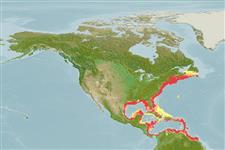Common names from other countries
Environment: milieu / climate zone / depth range / distribution range
Écologie
Benthopélagique; profondeur 0 - 400 m (Ref. 275). Tropical; 10°C - 14°C (Ref. 275), preferred 21°C (Ref. 107945); 50°N - 8°N, 98°W - 53°W (Ref. 275)
Distribution
Pays | Zones FAO | Écosystèmes | Occurrences | Introductions
Western Atlantic.
Length at first maturity / Taille / Poids / Âge
Maturity: Lm 15.0 range ? - ? cm Max length : 50.0 cm ML mâle / non sexé; (Ref. 275); 40 cm ML (female)
Common mantle length: 10.0 to 20.0 cm (Ref. 275, 3722). This is a neritic species found on sandy bottoms and along the water column (Ref. 83938). On coastal surface, epipelagic (Ref. 110525). Spends winter at depths of 100 to 200 m (Ref. 843). Overwinter along the continental shelf in offshore canyons as far south as Cape Hatteras (Ref. 106883).
Life cycle and mating behavior
Maturité | Reproduction | Frai | Œufs | Fécondité | Larves
Members of the class Cephalopoda are gonochoric. Male and female adults usually die shortly after spawning and brooding, respectively. Mating behavior: Males perform various displays to attract potential females for copulation. During copulation, male grasp the female and inserts the hectocotylus into the female's mantle cavity where fertilization usually occurs. Life cycle: Embryos hatch into planktonic stage and live for some time before they grow larger and take up a benthic existence as adults.
Roper, C.F.E., M.J. Sweeney and C.E. Nauen. 1984. (Ref. 275)
Statut dans la liste rouge de l'IUCN (Ref. 130435)
statut CITES (Ref. 108899)
Not Evaluated
Not Evaluated
Utilisations par l'homme
Pêcheries: commercial
FAO - pêcheries: landings, species profile | FishSource | Sea Around Us
Outils
Sources Internet
Estimates based on models
Preferred temperature
(Ref.
115969): 5.9 - 26.3, mean 19.4 (based on 245 cells).
Résilience
Haut, temps minimum de doublement de population inférieur à 15 mois (K=0.59-0.95).
Vulnérabilité
Low to moderate vulnerability (26 of 100).
